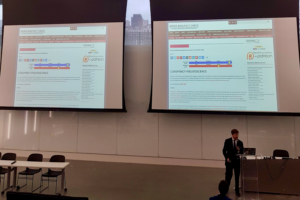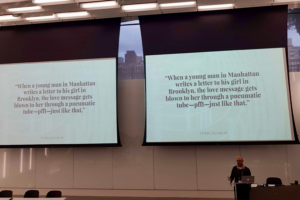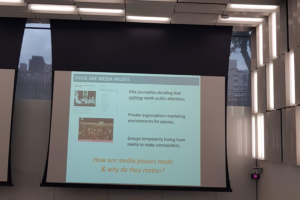Last semester I was lucky to have the opportunity to audit a few classes at the Graduate Center. Not only was I lucky for this, but also because when I arrived at the Grad Center, this was the first year these masters were happening. And that was a great surprise, since when I first manifested my wish of coming here I had no clue about it.
When I saw the courses, I could not help myself not asking if I could audit them. I was too curious, and the professors were kind enough to let me check them. I therefore audited the Introduction to DIgital Humanities (with Prof. Matthew Gold and Prof. Steven Brier), Data Analysis and Visualization (with Prof. Lev Manovich), and Data, Place, and Society (with Prof. Kevin Fergusson).
I loved them for very different reasons but I will let the full descriptions for separate articles. For now I will just accept Buzzfeed has influenced me in the creation of listicles, and proceed to such a list of what impressed me during these classes. Here we go.
- The courses had a very solid introductory basis. I believe these fields might seem a bit intimidating in the beginning, due to the fact they are quite new, and that they may involve digital skills. But the courses include readings that not only put the fields on the map, but also show how are they connected to other interests and topics. I might be biased, but I do believe most of these readings should be read by anyone who is at least interacting with Digital Media.
- The dialogue was fantastic. I mean it. I have never been in such efervescent and also productive group discussions. I am not sure if that happened because the readings were challenging, the topics were very hot, or because of the ways the classes activities were directed towards dialogue, but I am sure I have learnt a lot from these discussions.
- People come from different backgrounds, which generated very interesting debates. I really liked to listen to so many perspectives. People here come from Computer Science, History, Gender Studies, Media, Game Studies and so many more, and this is how you get to break your filter bubble and get a 360 degrees approach on a topic.
- Practical assignments were very useful. Students had practical, and also fun projects. From doing their data visualizations from scratch, to collecting different types of data, or doing text mining on favorite topics. This way, everyone could see that those intimidating methods, terms or subjects are not actually that far from the humanist research.
- Students have the possibility to ask for support from the Digital Fellows, as well as to attend workshops. And that is amazing. Imagine you are attending a Master program, you are interested in one particular topic, and you have got an entire team out there to hold hands while you struggle with, let’s say, learning Python for your data analysis. Workshops expand from writing for Wikipedia, to Machine Learning, GIS, and using Zotero for a better research. Wouldn’t that be more encouraging to actually develop your project? It was for me indeed.
- The courses teach you how to be a “doer”. In other words, how to practically build a project, while keeping in mind ethical, professional or social debates. This is a very important aspect, I argue, since many of the tech projects or startups out there actually lack the moral compass, or a theoretical framing of what they are doing.
- The syllabus is continuously updated with up to date texts. This should be normal, right? But it is not always that common. It could be so easy to stick to older books, instead of keeping an eye on all the news and points of view everyday, especially in a field that changes and move so fast.
- The professors were very cool. I know, it is such a shallow way of expressing it in an academic environment, but I believe that is a good description for the professors who manage to build a course according to a field’s needs, and also be able to have great debates and discussions with their students.
- Even though for many of the people attending the classes the fields were very new, the structure of the courses allowed anyone to enhance their own professions and interests. Basically, I can say that all these three courses help you not necessarily to switch to something new, but also to build up to your background with a very fresh perspective. It does not matter if you are a linguist, a historian, or a journalist; either way, these subjects will definitely help you get a better work or research.
- Last, but not least, these courses allow students to expand theoretical knowledge, enhance their critical thinking, and also acquire skills that are so valuable on today’s professional market.
This site (thehashtags.commons.gc.cuny.edu) is not an official site of the Fulbright Program or the U.S. Department of State. The views expressed on this site are entirely mine and do not represent the views of the Fulbright Program, the U.S. Department of State, or any of its partner organizations.




